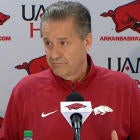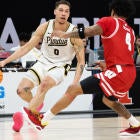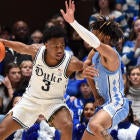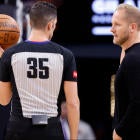This week's Talk to the Palm mailbag has a bit of Big East flavor while also touching on some of the non-major at-large candidates. Note the use of the term "non-major." There's been a lot of debate about which teams/conferences are mid-major and which are not, which is why I don't use that term. It's too vague and seems to offend nearly everyone attached to it.
Also, I hear a lot of people refer to Power Five teams in college basketball. That is a football designation. There are no fewer than six power conferences in college hoops, and the Big East is certainly one of those, even though it does not play football any longer.
Now, let's move on to this week's questions.
Q: I know this depends on how other teams perform over the final few weeks...but what do you think is the worst Butler could do over their final 5 games and still make the tournament? -- @ButlerGuru
A: The Butler Guru understands well that this is not just about Butler, rather how other teams perform. I do not think of Butler as a lock to make the tournament yet, and I define "lock" as a team that would still make the tournament if it lost all of its remaining games. The Bulldogs may be just one win away, though. The mistake Butler Guru made is that Butler does not have five games remaining -- they have at least six; the conference tournament counts, too. Most people forget that when asking these questions.
Q: What do you think Nova needs to get done to get placed at Madison Square Garden for the regionals? I'm assuming land on no worse than the 3 line but would that alone be enough? -- @Nova_Diddy
A: The answer to this question is that it depends on the competition for that site. It is possible for Villanova to be the No. 8 team overall in the field and get shipped away from the East region but remain out east if it simply swapped places with whichever team is No. 9. Look at San Diego State. The Aztecs are the fourth team overall but slotted for the East because the No. 3 team is also a fit out in the West. If San Diego State traded with any of the 2-seeds, they would be out in the West. They might even prefer that, but the committee will not lower a team's seed simply to fit a regional.
In Villanova's case, the competition may not come from just its seed line, but other Big East teams. Since Seton Hall is also a contender for a spot out in the East, if they are a higher seed and placed in the regional, Villanova cannot go there due to conference separation rules.
So, the answer is to get as high on the seed list as you can and hope for the best.
Q: I thought this would be a good time to revisit the top 5 non-major at large candidates beyond Gonzaga, SDSU, and Dayton. What do you think? -- @mikezor052588
A: Sounds like a plan. I'm going to leave out the A-10, American Athletic Conference and West Coast Conference because those conferences routinely put at-large eams into the field. Of course, by doing so, I have eliminated almost all of the candidates. One thing to keep in mind about all these teams is that in order to be an at-large team, they have to lose in their conference tournament.
- Northern Iowa.
- East Tennessee State
- Everyone else.
Sorry, I didn't make it to five. There are really just two potential at-large teams from outside the leagues that usually make it.
UNI has a win at Colorado but already has a couple of bad losses, which does not include the one at Loyola last week. That is the only team the Panthers can lose to. ETSU won at LSU but has losses at North Dakota State and at home to Mercer. That last one really hurts.
That brings me to the final question ...
Q: What's your take on Ken Pomeroy's article about Stephen F. Austin deserving to be in the at-large conversation? Will this catch the eyes of the committee and spark conversation in the committee room? Also, why isn't SFA on your bubble? -- @mgoring10
A: Well, I doubt that the committee takes counsel from Ken, myself or anyone else in the media. In fact, in a meeting with the NCAA a couple of years ago that we each attended, he told them they should not use his rankings because he is not measuring what they are trying to reward. Yet, his ranking still appears on the team sheet.
I understood Ken's point, which is primarily that strength of schedule shouldn't be everything, especially for teams like SFA because so much of its poor schedule is due to the league. And this league does its teams a disservice in the pursuit of an at-large bid by playing 20 conference games. Regardless, your schedule is your schedule, and that has always been important to the committee. It would be an easier argument to make if the Lumberjacks had not lost to Texas A&M-Corpus Christi at home. Also, like I said before, for them to be an at-large team, they have to take another really bad loss in the conference tournament.
Finally, the Lumberjacks also did themselves a disservice by playing three games against non-Division I opponents. If a team is serious about getting at-large consideration, it will never schedule more than one. They could have scheduled themselves a couple more chances at road wins over teams that could help them. Non-Division I games do not count in the rankings, but the committee will know about them. In terms of selections, nothing good ever comes from playing those games.





















